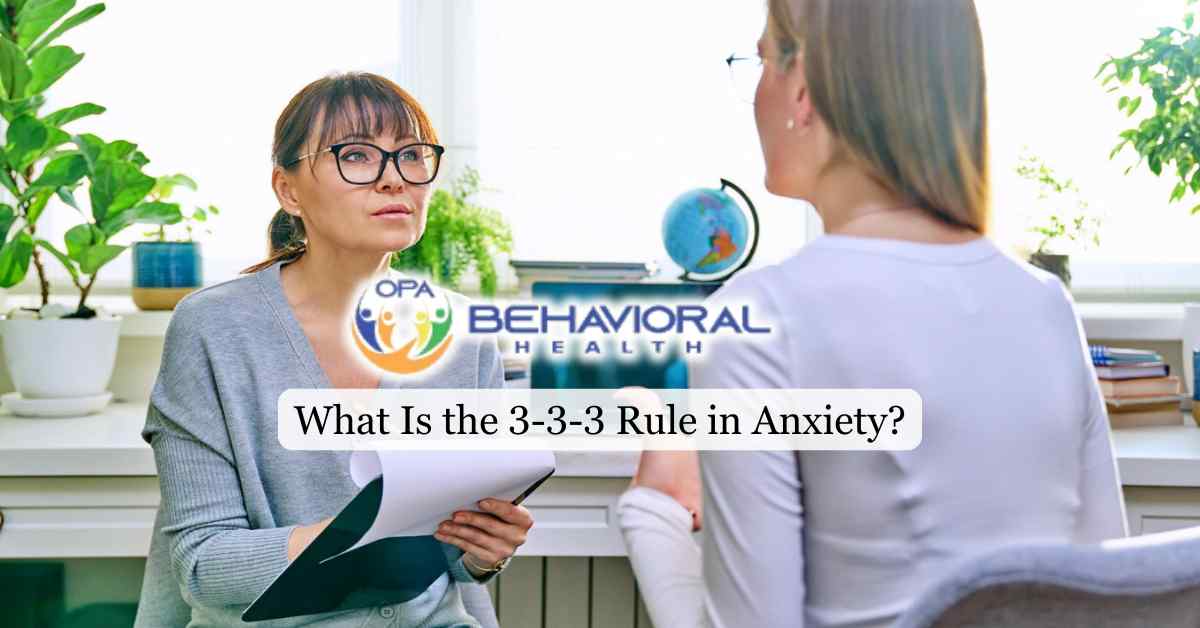In the modern fast-paced world we live in, many people experience anxiety, often feeling overwhelmed and disconnected from the present moment. To address these feelings, simple yet effective techniques are crucial for regaining control and fostering a sense of calm. One such method is the 3-3-3 Rule, a grounding exercise designed to provide immediate relief by anchoring attention to the here and now. This technique involves engaging the senses through a series of focused observations and movements, helping to interrupt anxious thoughts and promote mindfulness.
In this article, we will showcase the essence of the 3-3-3 Rule, how it works, and why it has become a valuable tool for managing anxiety in everyday life.

What Is the 3-3-3 Rule?
The 3-3-3 Rule is a grounding technique that offers a simple yet effective way to manage anxiety symptoms. When you’re feeling overwhelmed or anxious, the 3-3-3 Rule helps redirect your attention from distressing thoughts to your immediate surroundings. It’s a mindfulness practice that engages your senses, allowing you to focus on the present moment and regain a sense of calm.
To practice this grounding technique, start by identifying three things you can see in your immediate surroundings. Focus on the details of these objects, such as their colors, shapes, or textures. Next, find three things you can physically touch or move, like your clothing, a nearby object, or even your own body.
The beauty of the 3-3-3 Rule lies in its versatility and accessibility. You can practice it anywhere, at any time, making it a valuable addition to your coping skills toolkit.
Regular use of this technique can help you develop greater emotional regulation and resilience in the face of anxiety, empowering you to navigate challenging moments with greater ease.
How to Does the 3-3-3 Rule Work
When you start to feel anxious, take a moment to pause and observe your surroundings. Identify three objects and focus on their details. These could be anything from a tree outside your window to an item sitting on your desk. By concentrating on these objects, you can shift your attention away from those anxiety-inducing thoughts.
Next, pay attention to the sounds around you. Try to identify three distinct sounds. This might include the hum of a computer, birds chirping, or the distant noise of traffic. By analyzing these sounds, you can further anchor yourself in the present moment and distance yourself from feelings of anxiety.
Finally, engage your sense of touch by moving three parts of your body. You might wiggle your toes, roll your shoulders, or tap your fingers. This physical engagement helps ground you and provides a tactile distraction from anxiety.
Read more about What Causes Anxiety? to learn all the factors that impact the occurrence of this condition.
Scientific Basis of the 3-3-3 Rule
Grounded in neuroscience, the 3-3-3 Rule leverages the power of sensory engagement to interrupt anxious thought patterns and promote a sense of calm. By activating the parasympathetic nervous system, this grounding technique helps regulate the body’s stress response, reducing the intensity of anxiety symptoms.
Engaging in mindfulness through the 3-3-3 Rule allows you to shift your focus from anxious thoughts to the present moment. This practice creates a mental space between you and your anxiety triggers, enabling you to respond more effectively to stressful situations.
As a plus, incorporating physical movement while practicing the 3-3-3 Rule can further enhance its effectiveness in anxiety management. Moving your body helps release muscle tension associated with anxiety, promoting relaxation and a sense of control.
As you consistently practice the 3-3-3 Rule, you’ll strengthen your ability to manage anxiety in the moment and build long-term resilience.

Benefits of the 3-3-3 Rule
This technique helps you shift your focus away from anxious thoughts and onto your immediate surroundings. By identifying three things you can see, hear, and feel, you’re practicing mindfulness and anchoring yourself in the present moment. This interrupts the cycle of anxiety, allowing you to regain a sense of control and reduce overwhelming feelings.
Regularly using the 3-3-3 Rule can help you develop stronger coping skills and improve your overall emotional regulation. It’s a simple yet effective tool that you can use anytime, anywhere, making it a valuable addition to your anxiety management toolkit.
Whether you’re dealing with a panic attack or just feeling anxious, the 3-3-3 Rule is a simple and effective way to ground yourself and find relief. For additional support, OPA Behavioral Health offers anxiety treatment tailored to your needs.
Limitations and Considerations
While it can provide immediate relief during acute anxiety episodes, it’s crucial to understand that the 3-3-3 Rule is a temporary coping mechanism and not a substitute for professional treatment or therapy.
Its effectiveness may vary from person to person, as individual responses to grounding techniques can differ significantly. To optimize the benefits of the 3-3-3 Rule, it’s essential to complement it with other coping strategies and seek professional support for long-term anxiety management.
Practicing the technique in non-anxious moments may enhance its effectiveness, but over-reliance on the 3-3-3 Rule without addressing underlying anxiety issues can inhibit progress in treatment.
It’s important to note that there’s currently no formal research validating the effectiveness of the 3-3-3 Rule, highlighting the need for more scientific studies to assess its impact and benefits in anxiety management.
Find out what are the Signs It’s Time To Seek Professional Help For Anxiety and don’t overlook or postpone the need have this condition checked.
Final Thoughts from OPA Behavioral Health
While the 3-3-3 Rule can be a helpful tool for managing anxiety, it is not a substitute for professional treatment in cases of severe or persistent anxiety disorders. At OPA Behavioral Health we can help you adopt the proper set of anxiety-reducing techniques into your self-care routine. Our team strives to help anyone struggling with anxiety disorders be better equipped to handle anxiety when it arises and ultimately finding the inner calm fostering resilience in your daily life.








